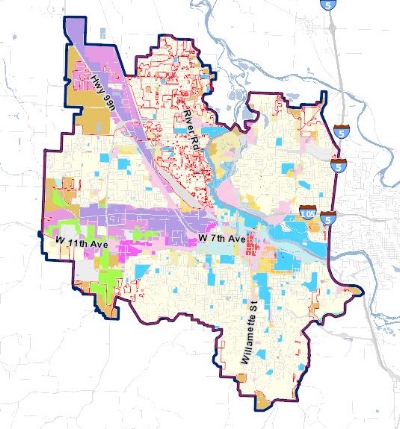When building something in Eugene, it needs to be in compliance with Eugene’s Zoning Code. There are processes in place for adjusting or varying from the underlying code for specific projects, but how does the code itself get changed? If there is a need to, for example, remove a provision or make a change, what are the steps?
A change to the zoning code itself is a legislative process, with City Council as the final decision maker. This is described as a Type V process in the Zoning Code (section 9.7500). The steps of this process are below and opportunities for public involvement are bolded:
1. Council formally initiates a Land Use Code Amendment process with a vote at meeting. The process can be identified either by:
a. A City Councilor identifying that a land use code amendment process is needed, and making a motion to initiate it;
b. City Staff recognizing that a land use code amendment process is needed, and recommending that Council move to initiate it
c. A person can make a written request, filed with the Planning Director, that Council initiate a Land Use Code Amendment process, which Council would then vote on.
2. City Staff would draft suggested code amendments based on the direction provide by Council. In many cases, they would also conduct public engagement or feedback gathering activities at this point. The level of public engagement is typically related to the complexity and impacts of the change being proposed.
3. Prior to the Planning Commission Public Hearing, City Staff would submit a written notice of the intended changes to the Oregon Department of Land Conversation and Development, as required by Oregon State Law. They would also mail a notice to all neighborhood groups officially recognized by the City Council, Lane County and City of Springfield planning directors, and community organizations that have submitted written requests for notification, and publish a notice in the newspaper of the proposed change. Typically information would also be posted on various online calendars, meeting agendas, and websites in addition to the newspaper.
4. The staff report to the Planning Commission would be made available to the Planning Commission and the public upon request. If worst comes to worst, someone can proactively go down to the Planning Offices at the Atrium building and ask for the materials, but frequently, this report would be included in the Planning Commission agenda for the public hearing and otherwise be emailed to interested parties and posted on the internet.
5. The Planning Commission would hold a public hearing on the proposed changes. Commenting and submitting written testimony to the Planning Commission is similar to commenting at a City Council meeting.
6. The Planning Commission deliberates about the proposed changes, makes suggestions, and votes on potential modifications. They can then recommend to City Council that they approve the changes, approve the changes with recommended modifications, or deny the changes.
7. The proposed changes then go to City Council, where another public hearing is held after notifying anyone who provided testimony for the Planning Commission or requested to be notified of the Planning Commissions actions.
8. After the public hearing, City Council can vote to modify the proposal. It is usually recommended that substantial modifications result in additional public hearings and/or review by the Planning Commissions, but this doesn’t always happen. City Council can then vote to approve or reject the proposal (as modified.) If it is approved, then it becomes the new zoning code. If it is denied, then no changes to the code are made.

